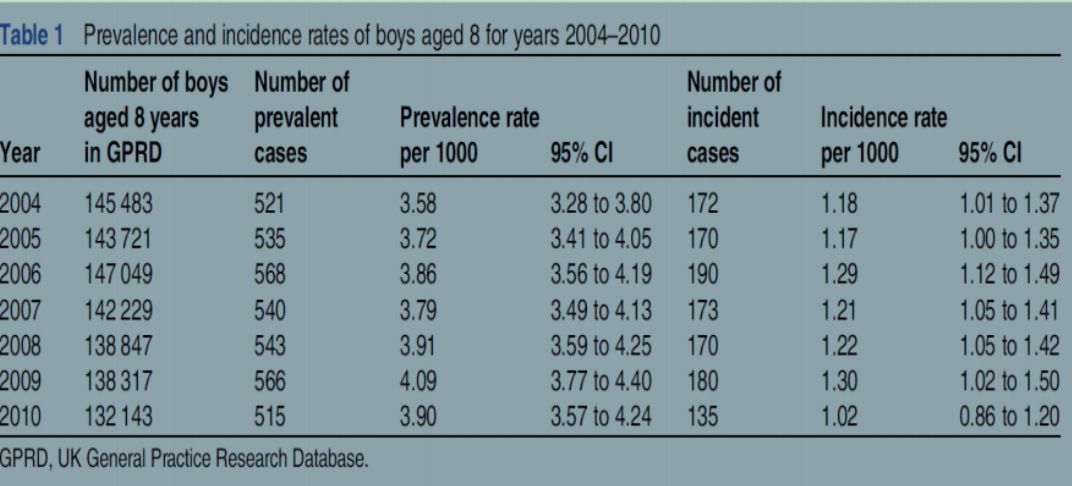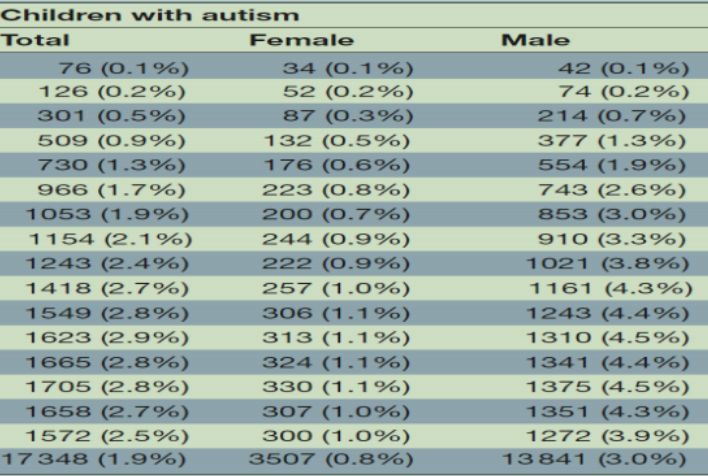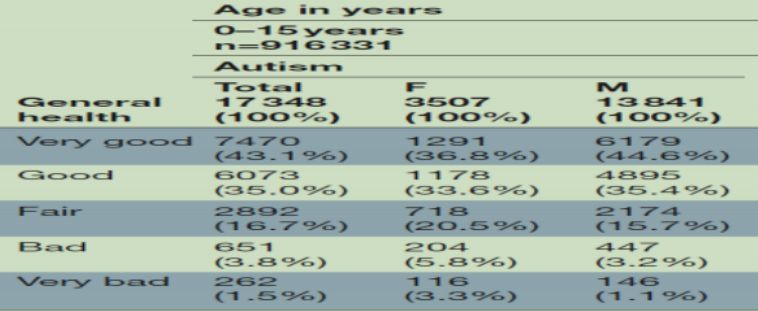Prevalence of Autism among children (boys and girls) in the United Kingdom from 2000 to 2020-Research Project
- Country :
Australia
Abstract:
The research is about the prevalence of autism among children (boys and girls) in the United Kingdom from 2000 to 2020. The research will use secondary data collection from available documents published by other authors. Findings of the research show that
Introduction:
According to the National Autistic Society (2020), Autism spectrum disorder is a developing illness that is noticeable by two uncommon types of behaviours: shortages in communication and social communication and limited or repetitive behaviours.
There is no sole source for it, and indications may be extremely slight or extremely severe. Some kids who are on the range begin presenting symptoms as young as a few months old. Others appear to have regular growth for the primary few months or years of their lives and then begin presenting signs (Renee, 2020).
Research Am:
The aim of the research is to assess the prevalence of autism among children (boys and girls) in the United Kingdom from the year 2000 to the year 2020.
Research Objectives:
- To assess prevalence of autism among children (boys) in the UK from 2000 to 2020.
- To explore prevalence of autism among children (girls) in the UK from 2000 to 2020.
- To match both prevalence of autism among children (boys and girls) in the UK from 2000 to 2020.
- To research for causes of difference in the rates of autism among children (boys and girls) in the UK from 2000 to 2020.
Research Questions:
- What is the prevalence of autism for children (boys) in the United Kingdom from 2000 to 2020?
- What is the prevalence of autism for children (girls) in the United Kingdom from 2000 to 2020?
- What is the difference in the rates of autism among children (boys and girls) in the UK from 2000 to 2020?
- What are causes of difference in rates of autism among children (boys and girls) in the UK from 2000 to 2020?
Keywords:
autism, childhood, boys, girls, prevalence, United Kingdom, 2000 to 2020.
Literature Review
This part of the research used secondary data collection to get reliable and valid information related to the topic for the completion of the research. The researcher used some search engines like PubMed and Google Scholar with key works to find suitable and reliable article journals to complete the research.
Prevalence of autism for children (boys) in the United Kingdom from 2000 to 2020
According to the Keyes et al., (2012) the table underneath displays the yearly amount of boys of aged 8 years likewise displays the yearly amount of boys of aged 2 to 8 years identified as autistic for the first time in every year from 2004 to 2010. The yearly amount of occurrence cases is once more curiously alike over time as is the number of boys lively in the practices every year, resultant in yearly occurrence guesses of approximately 1.2/1000 boys over years. The entire number of boys was 1190. The figure of girls originally identified as autistic from 2004 to 2010 was 217 girls.

Prevalence of autism for children (girls) in the United Kingdom from 2000 to 2020?
As per Keyes et al., (2012), the table below gives the yearly occurrence and prevalence rate guesses over time for girls. Girls were near one-fifth as probable to be identified with autism as boys.

- What is the difference in the rates of autism among children (boys and girls) in the UK from 2000 to 2020?
Table 1: Prevalence of childhood autism by gender

The above table shows the prevalence of autism in children by gender, and according to the statistics, is appears that in the total of 17,348 cases of autism in childhood, boys are the most to have more cases of autism (13,841 (3.0 percent) in children compared to girls with 3,507 (0.8 percent).
Table 2: General health status of children with autism

The table above displays general status of kids with autism by gender. It shows that boys with autism have very good health status with girls. That means girls with autism have very bad health status than boys with autism. According to the NHS (2019), Autism may occasionally be dissimilar in girls and boys. For instance, autistic girls might be noiseless, might hide their moods and might seem to manage well with social circumstances. That means autism may be tougher to identify in girls than boys.To originate the first methodically planned estimation of the relative amount of boys and girls with autism spectrum disorder over a meta-analysis of occurrence researches led since the starter of the DSM-IV and the Global Arrangement of Illnesses, Tenth Revision, results display that 54 researches were analysed, with 3,784,284 contributors, of whom 53,712 had autism spectrum disorder (Loomes et al., 2017).According to the research from Rydzewska et al. (2019), Autism was specified for 17 348/916 331 (1.9 percent) kids of aged 0 to 15, and 7715/632 488 (1.2 percent) adolescents of aged 16 to 24 years. The rate augmented to the age 11years old in boys and the age of 10 years in girls, reflecting the age at analysis. Occurrence was 2.8 percent at the age 10 years old (4.4 percent for boys; 1.1 percent for girls), and 2.9 percent at the age of 11 years old (4.5 percent for boys; 1.1 percent for girls).As er Zeliadt (2018), the greatest comprehensive analysis of sex ration of autism, issued in the year 2017, illustrated on statistics from 54 occurrence researches intentional. That investigation projected approximately 4.2 boys with autism for each girl. As per Rudy and Trelles (2020), grounded on fresh study, the differences between girls and boys with autism are:
- Boys with autism tend to have extremely monotonous and restricted field of play. Girls with autism are fewer monotonous and have wider field of play.
- Girls with autism are more probable than boys to be capable to react to nonverbal communication like directing or regard following. They are as well slightly more attentive and fewer disposed to interference.
- Whilst social communication of boys matters become challenging too early in their lives, girls might be capable to handle the social weights of premature childhood but run in worries as they go in premature adolescence.
- What are causes of difference in rates of autism among children (boys and girls) in the UK from 2000 to 2020?
Autism is pointedly more general in boys than in girls. This tilted sex ratio was known since the primary cases of autism were labelled in the 1940s. The real motives for the ratio are not clear. It might be rooted in biological variances among sexes. Or, some specialists state, it might be an object of how autism is well-defined and identified (Zeliadt, 2018). One possibly significant aspect is analytic prejudice: Many researchers suggest that girls receive autism identifies later in life than boys, representing that the disorder is tougher to identify in girls (Zeliadt, 2018).
In order with this though, the 2017 research discovered that the sex ratio drops to 3.25 boys for each girl when the examination comprises just the 20 researches in which investigators assessed the respondents for autism, somewhat than depend on preceding analyses (Zeliadt, 2018). Research by Butter (2017) displays that boys are at greater hazard for the wideranging hereditary sources of autism and other neuro-developmental situations than girls are. Study over the past many years displayed that smaller hereditary mistakes, or changes, and less of these mistakes, are related with autism syndrome disease amongst boys whilst more pronounced and serious genetic changes are detected when girls are identified with autism. The different outlines shown by kids with autism might favour the more serious and problematic indications detected amongst boys.
Therefore, boys get mentioned for analytical and therapy facilities earlier in growth than do girls and are more frequently identified. The supposed is that some girls are identified later in mid childhood, puberty, or even young adulthood whilst some girls might be missed and will never be suitably maintained.
Methods:
The research used qualitative research. Qualitative research emphases in understanding a study question as a human-centred or principled method. However, quantitative method is a more dependable technique as it is grounded upon numeric and approaches that may be completed objectively and spread by other investigators (Gibson et al., 2004)
Data Collection
Data collection is the procedure of collecting and assessing data on variables of attention, in a recognised methodical fashion that allows one to respond specified research queries, test theories, and assess findings (Madsen et al., 2002).
For the collection of information, secondary data collection was use, as secondary data is the information that has previously been gathered through primary sources and complete willingly accessible for investigators to utilise for their individual study. It is a sort of information that has previously been gathered in the past. An investigator might have gathered the information for a specific project, then made it accessible to be utilised by another investigator. The information might likewise have been gathered for common usage with no precise study purpose such as in the case of the nationwide survey (Formpl, 2020). The researcher used PubMed and Google engine to search for selected key words, and researcher found six article journals with relevant information on autism in children in the United Kingdom.
To confirm reliability and validity of information, the researcher compares some articles and perform an analysis of all articles and other information online. All articles selected were about autism in children or childhood.
Ethical Considerations
Ethical considerations are gathering of standards and values that address queries of what is better or bad in human matters. Ethics pursuits for motives for acting or ceasing from acting; for accepting or not accepting conduct; for trusting or refuting somewhat concerning good or vicious manner or well or evil instructions (Homan, 1991).
Through the carrying out of the research, the researcher complied with some rules like the Copyrights and patents, and all information collected during secondary data collection was rewrite and referenced.
Findings:
According to the Keyes et al., (2012) the table underneath displays the yearly amount of boys of aged 8 years likewise displays the yearly amount of boys of aged 2 to 8 years identified as autistic for the first time in every year from 2004 to 2010.As per Keyes et al., (2012), the table below gives the yearly occurrence and prevalence rate guesses over time for girls. Girls were near one-fifth as probable to be identified with autism as boys.
Discussion:
This section will enable to present the case study. Thomas (2017) clarifies what to show in discussion part of the research. Within the discussion parts the researcher is coming to complete circle and recurring to the initial query and the setting offered by the literature review.
As per Rudy and Trelles (2020), grounded on fresh study, the differences between girls and boys with autism are:
- Boys with autism tend to have extremely monotonous and restricted field of play. Girls with autism are fewer monotonous and have wider field of play.
- Girls with autism are more probable than boys to be capable to react to nonverbal communication like directing or regard following. They are as well slightly more attentive and fewer disposed to interference.
- Whilst social communication of boys matters become challenging too early in their lives, girls might be capable to handle the social weights of premature childhood but run in worries as they go in premature adolescence.
Research by Butter (2017) displays that boys are at greater hazard for the wideranging hereditary sources of autism and other neuro-developmental situations than girls are. Study over the past many years displayed that smaller hereditary mistakes, or changes, and less of these mistakes, are related with autism syndrome disease amongst boys whilst more pronounced and serious genetic changes are detected when girls are identified with autism.

